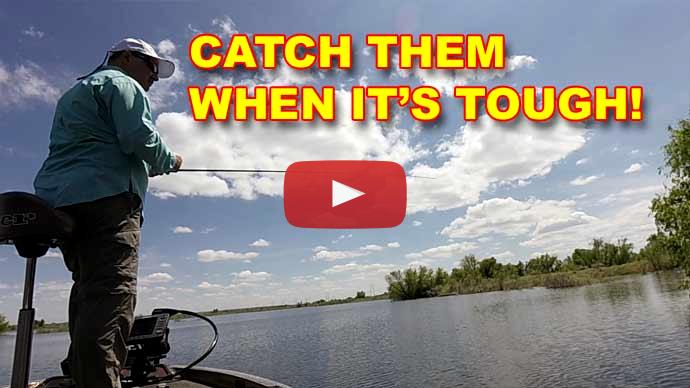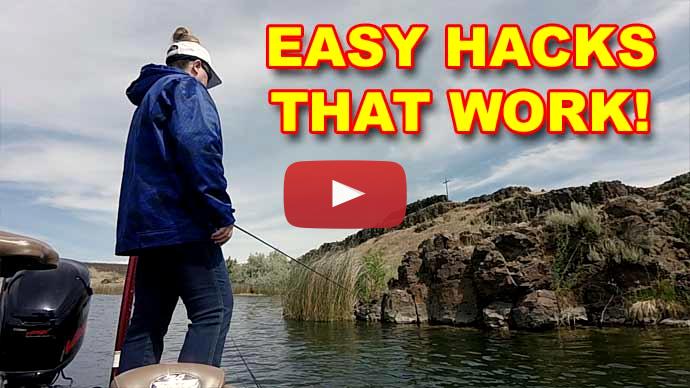All right, so you got some brand new lures, maybe some new gear, new rod reel, new tackle. Great. I love fishing with new stuff for bass. However, those aren't gonna do you much good if you can't find the fish, right? You gotta be on the fish first to use that stuff. And sometimes that can be the most difficult part of bass fishing is finding the fish. So today, we're gonna break it down real easy for you.
The best way to find them, first of all, is to break the lake down into two different categories. One is structure and the other is cover. So let's talk about structure first of all.
Structure is any kind of contour change on the bottom. It's actually the topography of the bottom of the lake or the river. The steeper the drop, the better. That's typically bass and baitfish are attracted to those steeper drops, a bigger contour change rather than this long flat tapering change. So look for things like that, like points, humps, ledges, ridge, creek channels, any kind of a drop, even steep banks on the shoreline, those type of things tend to be more productive.
And even sometimes it doesn't have to be a major drop. Say you got a big area with...it's basically flat bottom, but there might be a little creek channel in the middle of it. It's just a divot, maybe a foot, two-foot divot, but that's enough and the bass will congregate around that. They'll use that. So it doesn't have to be a big change. Sometimes a minor difference can really make a big impact on whether or not that area is productive. So contour changes, structure, that's what you're looking for. Humps, ridges. That structure, that's what attracts bass and baitfish.
Cover, on the other hand, is a little bit different. Cover is something that's either attached to the bottom or laying on the bottom or covers the top. So examples of that. Well, let's go into three different types of covers. That's probably the easier way to do it. So there's wood, weeds, and rock. Let's talk about wood cover first of all. Wood can be in the form of laydowns, you know, a tree fell down into the water, that's a laydown. Or it could be logs on the bottom, stumps. It could be the wood that are made out of docks, right? Dock pilings, bridge pilings. Wood. Now, wood can be good or bad as far as attracting bass. Typically, wood, it has algae on it that gets the zooplankton going, the baitfish come up and start feeding on that, and of course, that attracts the bass. So generally speaking, wood is a good thing.
However, if you're fishing a reservoir that's been around for a long time or a lake that's been around for a long time, and it's got a lot of wood in it, stumps or logs on the bottom, it can look real bassy, but it may not be very productive because after a while, the wood starts decomposing and when it's decomposing, it actually consumes oxygen. And that's not a healthy environment to grow all this algae and stuff the zooplankton live off of, and the baitfish aren't going to there, neither are the bass.
A good example of that is I got two lakes in my area. One's got a lot of logs on the bottom. That lake's been around for longer than I've been around, I'll tell you that. And the logs have been there that long, if not longer. And man, that looks great. You can see it. The water's pretty clear and you think, "Man, bass should be using that." They're not.
And then I got another lake that's full of stumps. It's loaded with stumps. And it used to be a really good bass factory, man. I tell you, years ago it used to be the place to go to catch a lot of big bass, but now it's not a very productive lake. And that's because all those stumps are now decomposing and rotting away, and it's not a healthy environment. So you've got to pay attention to that, the age of the lake and how long that wood's been in there, and it gives you an idea of whether or not they'll be productive. But they can be.
Most of the time, docks can be really good. Docks are kind of like the opposite of that. Like the older the docks, the better it is. I think that's just because more algae and more organic material is accumulated around the docks which attract the baitfish.
Floating docks, like the kind like you only want to stand on because you're afraid you're going to fall through or fall off, those for me tend to be some of the most productive ones. So pay attention to stuff like that. Sometimes you've got a whole row of great-looking docks and one that's really dilapidated. That might be the best one out of all the docks there. So wood. Wood is one type of cover.
Weeds are another. Weeds can be growing off the bottom in the form of strands, you know, milfoil, hydrilla, coontails grow that way, so the reeds. There's a lot of different types of weeds that grow off the bottom and some of them mat over and create canopies, and that creates shade underneath, which a lot of baitfish take shelter underneath and try to hide from the bass. Of course, that attracts the bass. So weeds also, when they're growing, produce a lot of oxygen. And so the environment in there, man, it's just its own ecosystem. Again, zooplankton is growing in there, baitfish are in there eating on that, the bass are in there, the panfish, brim, everybody. They're all like, "Lile in, come on, it's a big party." So weeds are...this is why a lot of really healthy, good fisheries all over the country contain an abundant amount of weeds because of this factor.
Now, one thing to pay attention to with weeds is learn the different types of weeds, and what kind of bottom that they grow on. Some weeds only grow shallow, some weeds will grow as deep as 20-feet deep, so it kind of helps you when you're finding areas to fish, you can get an idea of how deep it is underneath if you know the type of weeds and how deep they grow, but also the type of bottom composition. Some weeds grow well in softer bottoms like lily pads, whereas others grow in hard bottoms like reeds and cattails. This is really important, for example, when you're fishing in the spawn. If I go to a brand new lake I've never been to and I know the spawn is on or we're pre-spawn, I'll look for areas where there's reeds and pencil reeds, and go right to them and voila, there are the bass, they're there, they're getting ready to spawn, they want those hard bottoms to make their nests.
So understand your weeds. Now we're talking about reeds real quick. One of the things I've noticed, just in my own personal experience with reeds is when it gets really windy, the bass will vacate pencil reeds. I don't know why. I guess they don't like the reeds moving. That's the only thing I can think of. It's not because sometimes you think a wind is associated with the front, and so all the fish pull out and they're now deeper. That's not true. I've fished areas where I've gone in reeds like the day before, the fish are all in there, and then the next day there's some wind like in the morning, there's just a big temperature shift so there's a lot of wind going on. And there's no bass in those reeds, but you can go nearby into mill foil or lily pads in the same depth, and there's the fish. They're right there. So it's just something to do with reeds moving when the wind gets going that turns the bass off. So learning about your different weeds and weeds type and how the bass use them throughout the year can really help you become a productive angler.
The other kind of cover is rocks. Now rocks obviously aren't organic in their own, but what rocks do is they collect debris and they have algae that grows on them and they collect organic material. This, again, brings in the zooplankton, the bait fish will feed on that, and of course that attracts the bass. It also a lot of times brings in crawdads. Crawdads like to feed on all that organic material and they can get in the rocks and everything. and of course, crawdads are...you know, that's a treat for bass, so that's going to bring them in too. So anywhere you can find, like riprap, scattered chunk rock, gravel banks, anything like that that has rock can be very productive for bass fishing.
So the way to go after those is, you know, fishing with crankbaits, crankbaits bouncing off of them. You can throw plastic worms, you can throw topwater baits over the top, it's just a variety of different ways you can go and fish rocks, but don't pass them by because they can be very, very productive.
The key thing here between structure and cover is if you can find a combination of the two. Now you've found a hot spot. So if you're fishing a point, for example, and it's got scattered chunk rock on it, or scattered stumps, or it's got some weeds on it, that can be a hot spot. You have a hump and at the top of the hump, there's a bunch of weeds on top. That can be a hot spot. Anything like that where you can find a combination of a cover with the structure, those are the places you want to target when you're bass fishing.
Once you can find where the bass are located on the lake, that's when you can break out all your new gear and your new lures, and go to town and have yourself a ball. Hope that helps. For more tips and tricks like this, visit bassresource.com.



